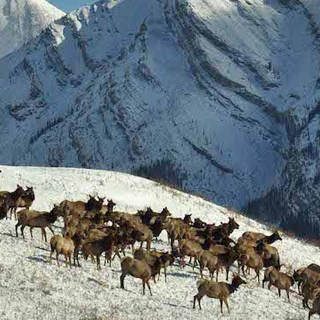Reports
Martin, H., and M. Hebblewhite. 2022.
Martin, H., and M. Hebblewhite. 2022. Elk (Cervus canadensis) and Bison (Bison bison) Share Space and Resources without Evidence of Competitive Exclusion Following Bison Reintroduction to Banff National Park. Speedgoat Wildlife Solutions LLC and Wildlife Biology Program, University of Montana, Missoula, Montana.
Ya Ha Tinda Four-Year Final Report: Long-term Monitoring of the Partially Migratory Ya Ha Tinda Elk Population, Predators, and Foraging Resources - Final Report 2017–2021
This report summarizes research activities and population monitoring from 2017-2021 for the Ya Ha Tinda elk research project in accordance with our recently completed four-year Parks Canada research permit and annual research permits with Alberta Environment and Parks. We also summarize research output, conferences, talks and public outreach. Download a PDF of this report.
Ya Ha Tinda Elk Project Annual Report 2019
This report summarizes activities from the long-term studies of the Ya Ha Tinda elk population up to summer 2019. The report also includes summaries of five graduate and undergraduate student projects including bull elk ecology, parasitology of migratory and resident elk, winter behavioral observations, and remote camera-based research on predator-prey spatiotemporal dynamics estimating calf:cow ratios using remote cameras. We also summarize scientific and public communication in the last two years. Download a PDF of this report.
Ya Ha Tinda Elk Project Annual Report 2016-17
This report summarizes activities from the long-term studies of the Ya Ha Tinda elk population up to Summer 2017. The report also includes summaries of 3 subprojects within our overall project; preliminary results from our study of elk calf survival, results of a predator scat distribution and diet study, preliminary results from intensive and extensive camera trapping, results of a new parasitology study. We also summarize scientific and public communication in the last 5 years. Download a PDF of this report.
Annual Project Report - NSF - 2016-17
A portion of the report submitted to the National Science Foundation for NSF-LTREB Award 1556248, covering reporting period 05/01/2016-04/30/2017. Download a pdf of this report.
Ya Ha Tinda Elk & Predator Study Annual Report 2015-16
This report summarizes activities from the long-term studies of the Ya Ha Tinda (YHT) elk herd, including monitoring of adult female elk survival/mortality, migratory behavior, pregnancy rates, population size, ungulate pellet group counts, and grassland production on YHT grasslands up to 15 March 2016. It also includes preliminary info on elk calf survival and cause-specific mortality and a predator scat distribution study. Download a pdf of this report.
Progress Report 2014
This report summarizes activities from the long-term monitoring of the Ya Ha Tinda (YHT) elk herd and second-year efforts (1 April 2014 to 15 October 2014) aimed at understanding the role of calf survival in the persistence of the YHT elk population. Download a pdf of this report.
Long Term Population Dynamics and the Effects of Prescribed Fire on the Winter Range of the Ya Ha Tinda Elk Herd
This report contains data collected as part of a long-term monitoring of the Ya Ha Tinda elk (Cervus elaphus) population dynamics and vegetation project, and the first season of a two year study on elk demography and winter range ecology. Authors: Scott Eggeman, Mark Hebblewhite, Lindsay Glines, Evelyn Merrill. Summer 2010. Download a pdf of this report.
Linking Predation Risk and Forage to Ungulate Population Dynamics
In this dissertation, I examine how multi-scale resource selection by migrant and resident elk (Cervus elaphus) differentially influence demography. I studied the partially migratory Ya Ha Tinda elk population, which winters in the province of Alberta and migrates in summer to Banff National Park. Author: Mark Hebblewhite; PhD dissertation. Read a pdf of this report.
Ya Ha Tinda Elk Herd and Red Deer River Valley Ecotone Study: Final Report
This report serves to summarize: 1) data collected as part of a long-term monitoring of the grassland vegetation, population demography, and distribution of the Ya Ha Tinda (YHT) elk herd, 2) an analysis of long-term grassland change and current grassland ecotones, and 3) an update on the effects of summer aversive conditioning on elk distribution. Authors: Scott Eggeman, Alexander Deedy, Mark Hebblewhite. November 2011. Download a pdf of this report
Ya Ha Tinda Elk Aversive Conditioning Project Summer Elk Range Surveys 27, 28, 29 July 2007
In this final year of the Ya Ha Tinda Aversive conditioning project aerial summer range surveys were conducted in cooperation with Dr. Hebblewhite by repeating surveys that were completed in the summers 1977, 1978 and 1979 (Morgantini 1982) and 2003 and 2004 (Hebblewhite 2006). This comparison will help to determine the larger-scale changes in elk distribution associated with this project. Author: Holger Spaedtke. 2007. Download a pdf of this report.
Ya Ha Tinda Exclosure Study: Plant Composition & Fescue Growth
In response to concerns about the fescue grasslands, six exclosures were established by Parks Canada at Ya Ha Tinda in fall 2000 for initiating studies on the integrity of the fescue grassland with and without grazing. Exclosure sites were selected to represent the range of grassland productivity and types of elk use on the ranch at the time. Authors: Evelyn Merrill, Heather McPhee, and Barry Robinson. 2007. Download a pdf of this report.
Effects of Post-Fire Logging on Elk Habitat During the First 3 Years Post-Fire: A Case Study of the Dogrib Creek Fire in the Eastern Slopes of Alberta
In the fall of 2001, the Dogrib fire burned 102 km2 of pine and spruce forests southeast of the Ya Ha Tinda Ranch, home to one of Alberta’s largest elk herds. Following the fire, Sundre Forest Products (formally Sunpine Forest Products) salvage logged 25% of the burn. Download a pdf of this report.
Fescue Grassland Response to Seasonal Grazing Regimes: Progress Report
Because both domestic and native grazing occur in foothills along the Red Deer drainage, this location provides an excellent site to study the utilization patterns of domestic and native herbivores and the response of rough fescue to seasonal grazing regimes. Author: Leslie Erica McInenly. May 2002. Download a pdf of this report.
